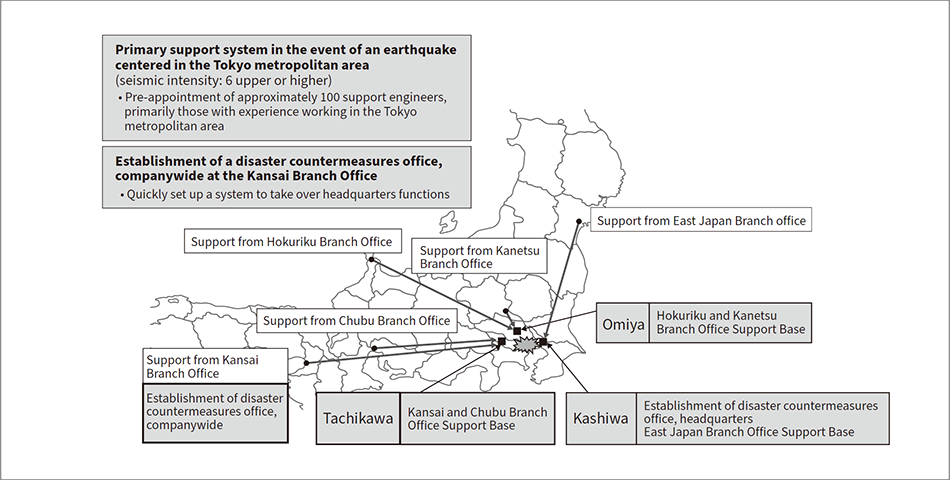The vertical mobility infrastructure provided by elevators and escalators plays a crucial role in modern urban life. Therefore, a widespread interruption of elevator and escalator service can cause the lives of people in the city to come to a stop. Consequently, more efficient systematic support and more efficient recovery work is needed to respond to the extensive number of simultaneous elevator shutdowns caused by big and widespread earthquakes and other widespread disasters. As a manufacturer of elevators and escalators, Hitachi strives to minimize the damage to equipment when an earthquake occurs, to prevent users from being confined, and to ensure the safe and comfortable operation of elevators and escalators. Also, Hitachi has taken measures to recover quickly when elevators and escalators stop due to any cause. This article presents the earthquake countermeasures and services of Hitachi elevators and escalators.


A business continuity plan (BCP) is an action plan created to enable a company, government agency, or other organization to continue its core business and quickly resume other operations as soon as possible in the event of a large-scale disaster or accident. It can minimize the damage and the impact on service users by specifying the priority level of each operation beforehand, and taking measures such as providing backup systems and allocating recovery workers.
Hitachi Building Systems Co., Ltd. has established preventive measures to minimize damage to elevators and escalators in preparation for emergencies such as major earthquakes, widespread power outages, and other widespread disasters, as well as instituting response systems and emergency action plans for use when damage is sustained. The company is working to improve both aspects of BCP software and hardware so that elevator and escalator services can be quickly restored. This article will explain the earthquake damage countermeasures for elevators and escalators and the efforts made by the recovery system. And for other building facilities, BCP is similarly strengthened.
This section describes the changes in the seismic code and Hitachi’s hardware efforts in the area of earthquake countermeasures.
After the Miyagi Offshore Earthquake in 1978, a stricter seismic code for building structures was imposed and it became obligatory that “buildings will only suffer minor damage from earthquakes of about mid-level seismic intensity about 5, and that building collapse will be prevented in earthquakes of about seismic intensity 6 to 7” (see Figure 1). At the same time, elevator and escalator design and construction guidelines were established and standardized in 1981. These guidelines covered areas such as the five items shown in Figure 1, including maintaining functionality and the installation of seismic control operation systems after earthquakes with intensity 5 lower [Seismic code (1981)].
“The 1995 Southern Hyogo Earthquake (the Great Hanshin-Awaji Earthquake)” resulted in many cases of elevator damage from fallen counterweight blocks, toppled or broken equipment, and snagged ropes, and so earthquake resistance improvements targeting these issues were added in 1998 [Seismic code (1998)]. In response to the 2005 “Northwestern Chiba earthquake”, the Panel on Infrastructure Development created guidelines in 2009 for implementing earthquake readiness measures. These guidelines instituted requirements for the installation of seismic control operation systems (P-wave control operation) and specified methods for rescuing trapped elevator passengers and reducing user disruption after an earthquake [Seismic code (2009)]. And “the Tohoku Earthquake (Great East Japan Earthquake)” that occurred on March 11, 2011 was the largest earthquake ever recorded around the Japanese archipelago, and it resulted in 8,921 damaged elevators (damage ratio 2.43%) and 1,598 damaged escalators (damage ratio 3.9%) over a widespread area, but the damage to equipment compliant with “the Seismic code (2009)” was relatively lower (damage ratio 1.13% for elevators and 2.0% for escalators). However, there were cases of major damage, including 49 cases of fallen elevator counterweight blocks, 255 cases of escalator misalignment, and 4 cases of escalators detaching and falling(1). This led to a review of the laws and regulations affecting the safeguarding of human life, and resulted in the 2014 revision of the Guide to the Design and Construction of Earthquake-resistant Elevators and Escalators(2) [Seismic code (2014)].
Figure 1 — Changes in Seismic Code Due to Past Earthquakes The seismic code is reviewed as needed due to the occurrence of major earthquakes and based on safety reviews.
The seismic code is reviewed as needed due to the occurrence of major earthquakes and based on safety reviews.
Long-period ground motion is a low-frequency vibration that travels long distances without attenuation, and it is undetectable by conventional P-wave (preliminary wave) and S-wave (secondary wave) seismic detectors when the acceleration is low.
Hitachi Building Systems has developed and applied a seismic control system for long-period ground motion that plays a key part in building an elevator system that is less susceptible to damage from earthquakes. This system draws on Hitachi’s proprietary long-period ground motion response technology know-how and a predictive function that focuses on the mechanisms of long-object (elevator rope and traveling cable, etc.) swing arising, growth, and convergence, enabling optimal operation control in response to the amount of swing of a long object(3) (see Figure 2 and Figure 3).
Elevator passengers may become trapped in elevator cars when a power failure causes the elevator to stop between floors. To prevent passengers from becoming trapped, the Enforcement Order of the Building Standards Act was partially revised in 2009 to require that elevators be installed with a backup power supply system(4). Since the enactment of this enforcement order, elevators are required to be equipped with a control system using power from an emergency generator power supply or a battery-powered automatic floor landing system for power failures (see Figure 4).
Figure 4 — Overview of Control Systems for Power Failures If no power supply is available from the emergency generator power supply, an automatic floor landing system is used to prevent passengers from being trapped in elevators during a power failure.
If no power supply is available from the emergency generator power supply, an automatic floor landing system is used to prevent passengers from being trapped in elevators during a power failure.
HERIOS*1 Drive system is a function that switches the elevator to seismic control mode when an earthquake with an intensity of 5 lower occurs, stopping the elevator car at the nearest floor. And once the passengers have evacuated, the elevator automatically enters a diagnostic operation mode after a preset time has elapsed. If it does not have any trouble, the elevator automatically restores service temporarily(5). Inspection must be completed by a field engineer for full recovery (see Figure 5).
Figure 5 — Overview of Automatic Diagnostic and Recovery System This flowchart shows the automatic diagnostic and recovery system for elevators without a machine room.
This flowchart shows the automatic diagnostic and recovery system for elevators without a machine room.
In intermediate layer seismic isolation buildings, a seismic isolation device is installed in the middle part of the building, thereby preventing damage by reducing the swing during an earthquake. The device moves differently in the upper and lower part of the seismic isolation device of the building during an earthquake, so the elevator must have a structure that can handle the relative horizontal displacement between the buildings (seismic isolation displacement). Hitachi has developed a lineup of elevator systems for intermediate layer base isolated buildings, including a structure where the floor-door support frame is attached to the support structure for systems with a support structure, and a structure where the floor-door support frame is attached to the entrance/column for systems without a support structure.
The earthquake recovery system is the result of repeated review after each earthquake occurs. The northwestern Chiba earthquake occurred in 2005 and it was detected at a maximum seismic intensity of 5 upper mainly in the Tokyo metropolitan area.
Approximately 64,000 elevators, including those manufactured by other companies, stopped for long periods of time after seismic control operations, and resulted in 78 cases of trapped passengers(6), and some people were trapped for a long time. This earthquake provided an opportunity for elevators to be recognized and highlighted as a form of vertical transportation and social infrastructure, and for Hitachi to improve its recovery organization/system.
In 2006, the government discussed and established a law on earthquake countermeasures for elevators. Meanwhile, the Tokyo Metropolitan Government appointed the Japan Elevator Association (Kanto Branch) as a designated regional public agency under the Disaster Countermeasures Basic Act. In response to the growing social responsibility of the elevator industry, Hitachi Building Systems determined that systematic and continuous efforts were necessary, and in 2008, it eliminated the existing project system, and established the Widespread Disaster Prevention Office to enhance the system.
Figure 6 — Widespread Disaster Recovery Response Training Training was conducted by simulating an actual disaster, with each person wearing a vest that clearly defined his or her role.
Training was conducted by simulating an actual disaster, with each person wearing a vest that clearly defined his or her role.
In each region, trainings are conducted regularly every year to verify the rapid recovery response system for elevators, chillers, and building facilities in the event of a widespread disaster (see Figure 6).
The training primarily consists of the following elements.
To improve response capabilities, a system has been established to centrally manage the dispatch instructions and recovery status over the company’s information network from the occurrence of a disaster to the completion of recovery(7) (see Figure 7). The main functions of this system are as follows.
Hitachi is implementing the following measures to ensure the safety of employees and ensure the smooth establishment of a system for the recovery of elevator and escalator equipment when a disaster occurs.
The two control centers in East and West Japan are used to remotely monitor and control elevators and building facilities nationwide, distribute information to business sites, and monitor the maintenance status. These control centers have a backup system in place so that the functions of the control center in an affected area can be quickly transferred to the other control center during a widespread disaster.
Depending on the situation at the time of a disaster, a support system utilizing approximately 300 offices/sales branches throughout Japan will be established when a disaster occurs in the Tokyo metropolitan area, and assistance for recovery work will be provided from offices/sales branches unaffected by the disaster (see Figure 9).
In a company-wide widespread disaster recovery response drill held on National Disaster Preparedness Day, September 1, 2016, Hitachi Building Systems verified its response to a situation where a substitute disaster countermeasures office was set up at the Kansai Branch Office (Kita-ku, Osaka) assuming that said office could not be set up at the headquarters (Chiyoda-ku, Tokyo) due to an earthquake with an epicenter in the Tokyo metropolitan area. Since then, training has been conducted every year for selected verification items.
Figure 9 — Support System when Disaster Occurs in Tokyo Metropolitan Area Support staff will be received at three bases (Omiya, Kashiwa, and Tachikawa) and dispatched from there to each sales office in the Tokyo metropolitan area.
Support staff will be received at three bases (Omiya, Kashiwa, and Tachikawa) and dispatched from there to each sales office in the Tokyo metropolitan area.
When the Great East Japan Earthquake struck in 2011, Mito Works (Ibaraki Prefecture), which was the production base for elevators and escalators, was damaged and production had to be temporarily stopped. There was a wide range of items that needed to be addressed, including damage to lifelines, buildings, and production facilities, disruption to transportation routes, and damage to suppliers.
In response, Hitachi is reviewing its initial BCP, including the recovery procedures for damaged buildings, with the goal of recovering production as soon as possible, and at the same time, it is systematically strengthening the earthquake resistance of buildings and expanding facilities. In addition, a production system has been built for recovering production and to support maintenance sites as soon as possible such as by establishing a communication and cooperation system with suppliers and studying alternative transportation routes, etc.
In the Kumamoto earthquake of 2016, about 15,000 elevators, including those manufactured by other companies, stopped, and over 1,000 of them were damaged. Thirty minutes after the earthquake, Hitachi Building Systems set up disaster countermeasures offices at the company headquarters and its Kyushu Branch Office (Fukuoka Prefecture, now West Japan Branch Office) to collect information and assist affected areas. The entire company came together as one Hitachi to provide assistance for about a month starting from the early morning after the quake for providing improved disaster relief capabilities. The support work included dispatching over 400 staff from unaffected areas. The ability to provide this kind of support was made possible by the earthquake response measures described in this article and the sense of mission to protect social infrastructure felt by each and every employee who worked round-the-clock with single-minded dedication to the relief effort. Hitachi will continue working on innovating technology and improving quality to further enhance safety and security, while improving professional skills and awareness through regular training, and maintaining a system to ensure that it can respond to any situation at any time.